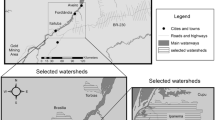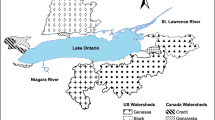Abstract
A mass balance model was developed to simulate mercury (Hg) cycling in Onondaga Lake, New York. MERC4, a U.S. Environmental Protection Agency model of the physical and biogeochemical transport and transformation of Hg, was modified by the addition of input from two supporting models (Fish Bioenergetics Model 2 and a lake eutrophication model) to model the transport of Hg into and out of plankton and fish. The model calculates the concentrations of total Hg, methylmercury, elemental Hg, and ionic Hg in both dissolved and particulate forms in the water column. The model was calibrated to an extensive data set of temporally and spatially variable Hg concentrations in Onondaga Lake in 1992. In addition to standard transport processes of advection and dispersion included in MERC4, the Onondaga Lake Mercury Model includes remineralization to simulate release of Hg from settling particulates before incorporation into sediment. The model provides an analytical framework for understanding and predicting the behavior of Hg in Onondaga Lake and has potential use in evaluating the relative impact of different source control and remedial alternatives.
Similar content being viewed by others
References
AScI: 1992,MERC4: A mercury transport and kinetics model (beta test version 1.0) model theory and user's guide. AScI Corporation, Athens, GA.
Bloom, N.S.: 1994, Influence of analytical conditions on the observed “reactive” mercury concentraitons in freshwaters, in C.J. Watras and J.W. Huckabee (eds). Mercury Pollution: Integration and Synthesis, Lewis Publishers, Boca Raton, FL.
Furutani, A. and Rudd, J.W.M.: 1980,Appl. Environ. Microbiol. 40, 770–776.
Gilmour, C.C.: 1995, this volume.
Gilmour, C.C. and Henry, E.A.: 1991,Environ. Pollut. 71, 131–169.
Harris, R.C.: 1991, A mechanistic model to examine mercury in aquatic systems, M. Eng. thesis, McMaster University, 278 pages.
Henry, E.A., Dodge-Murphy, L.J., Bigham, G.N., Klein, S.M. and Gilmour, C.C.: 1995, this volume.
Hewett, S.W. and Johnson, B.L.: 1991,Fish bioenergetics model 2: an upgrade of a generalized bioenergetics model of fish growth for microcomputers. University of Wisconsin Sea Grant Institute, Madison, WI.
Hudson, R.J.M., Gherini, S.A., Watras, C.J. and Porcella, D.B.: 1992, (abstract) International Conference on Mercury as a Global Pollutant, Monterey, California, May 31–June 4.
Hurley, J.P., Krabbenhoft, D.P., Babiarz, C.L. and Andren, A.W.: 1994, ‘Cycling of mercury across the sediment-water interface in seepage lakes’, in L.A. Baker (ed.).Environmental Chemistry of Lakes and Reservoirs, American Chemical Society, Washington, DC.
HydroQual: 1994, Onondaga Lake Calcite Modeling Report, Hydroqual, Inc., Mahwah, NJ.
Jacobs, L.A., Klein, S.M. and Henry, E.A.: 1995, this volume.
NOAA: 1992,Local climatological data monthly summaries (January–December 1992), Hancock Airport, Syracuse, NY. National Oceanic and Atmospheric Administration, National Environmental Satellite Data and Information Office, National Climatic Data Center, Asheville, NC.
Ramlal, P.S., Rudd, J.W.M. and Hecky, R.E.: 1986,Appl. Environ. Microbiol. 51, 110–114.
Tetra Tech: 1992,Instructions for running the MCM Lake Mercury model, Lafayette, CA.
U.S. EPA: 1991,WASPS.x, a hydrodynamic and water quality model: model theory, user's manual, and programmer's guide. US Environmental Protection Agency, Environmental Research Laboratory, Office of Research and Development, Center for Exposure Assessment Modeling, Athens, GA.
USGS: 1993,Final 1992 and provisional 1993 water year flow records, and final 1992 and provisional 1993 lake elevations). U.S. Geological Survey, Ithaca, New York.
Walker, W.W.: 1991,Compilation and review of Onondaga Lake water quality data, prepared for Onondaga County Dept. of Drainage and Sanitation, Syracuse, NY. William Walker, Environmental Engineer, Concord, MA.
Winfrey, M.R. and Rudd, J.W.M.: 1990,Can. J. Fish. Aquat. Sci. 44, 750–757.
Author information
Authors and Affiliations
Rights and permissions
About this article
Cite this article
Henry, E.A., Dodge-Murphy, L.J., Bigham, G.N. et al. Modeling the transport and fate of mercury in an urban lake (Onondaga Lake, NY). Water Air Soil Pollut 80, 489–498 (1995). https://doi.org/10.1007/BF01189699
Issue Date:
DOI: https://doi.org/10.1007/BF01189699




